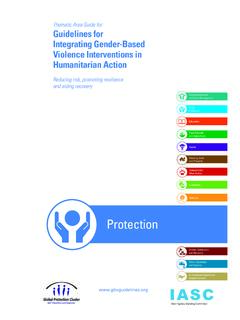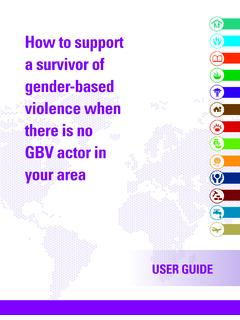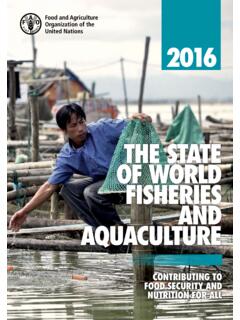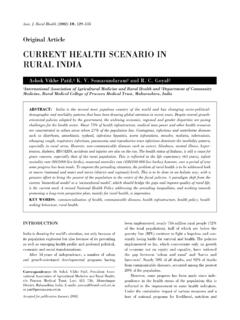Transcription of Gender-Based Violence Manual
1 November 2016 Gender-Based Violence Manual Emergencies and Transitions Unit (OSZPH) Programme and Policy Division 2 3 Table of Contents About This Manual .. 5 Part 1: Introducing Gender-Based Violence .. 7 Definition, causes and consequences of GBV .. 7 Protection from Sexual Exploitation and Abuse (PSEA) .. 8 WFP s approach to GBV .. 8 GBV as a protection and gender concern for WFP .. 9 GBV and food insecurity .. 9 The concentric circles model .. 10 Policy Framework .. 12 WFP s commitment to GBV .. 12 Policy on Humanitarian Protection .. 12 gender Policy 2015 2020 .. 12 Commitment to Accountability to Affected Populations (AAP) .. 12 Global Commitments .. 12 Part 2: Integrating GBV into WFP Operations .. 15 GBV in the Project Cycle .. 15 GBV analysis .. 15 Project Formulation .. 18 Project Review and Approval .. 19 Project Implementation .. 19 Monitoring and Reporting .. 19 Evaluation .. 20 Accountability to Affected Populations.
2 20 GBV in WFP Programmes .. 21 General Distribution: selecting and implementing a GBV-sensitive transfer modality .. 21 Livelihood, agriculture and market-access programmes .. 25 School feeding .. 29 Nutrition and HIV .. 31 PART 3: Addressing GBV Incidents through Referrals .. 35 GBV referral methods .. 35 GBV referrals in the WFP operational environment .. 35 Developing a GBV Referral Strategy .. 36 PART 4: Advocacy and Partnership .. 39 Advocacy .. 39 Partnerships .. 40 4 5 About This Manual What is it? This Manual provides an overview of the key issues related to Gender-Based Violence (GBV) in the context of WFP s operations. It seeks to guide staff and partners so they can better identify and respond to GBV risks related to hunger and nutrition and to WFP programmes. In particular, the guidance aims to identify practical steps to ensure that WFP staff are able to: Understand what GBV means; Understand how GBV is relevant to WFP; Conduct GBV analysis in order to identify GBV-related threats, vulnerabilities, capacities, gaps and opportunities; Apply specific measures to prevent, mitigate and respond to GBV threats within the context of WFP s activities; Identify opportunities to address GBV through food assistance, thereby achieving a dual objective of food security and protection; Monitor GBV risks in the operational context; Refer GBV survivors to appropriate service providers in a safe and ethical way; and Manage GBV case reporting in a safe and ethical way.
3 Who is it for? This guidance is intended to reach all WFP staff and partners. It is especially important for those who are involved in one or more steps of WFP s programme cycle, including managers, programme officers and field monitors. How should it be used? The guidance should be used as a reference tool for integrating GBV as a protection concern into WFP operations. It does not provide a comprehensive overview of all types of GBV risks. Rather, it serves to guide staff through the process of identifying relevant GBV risks in their operational country context. It is ultimately up to WFP staff to determine how to adapt and apply the guidance to their situation. This guidance should be reviewed before planning, implementing and monitoring programmes and field activities. Structure The guidance is divided into the following sections: Part 1 Introducing GBV Introduces the broader concept of GBV, explains WFP s approach to GBV, and provides the policy framework for GBV as a protection concern for WFP.
4 Part 2 Incorporating GBV in WFP Operations Outlines how to conduct a GBV analysis, explains incorporation of GBV in the programme cycle and provides a generic GBV risk analysis for each modality and programme type. Part 3 Addressing GBV Incidents Through Referrals Outlines the process by which WFP staff should refer protection and GBV incidents that go beyond their expertise or capacity to respond; and Part 4 Advocacy, Partnerships and Coordination Explains GBV advocacy, introduces key actors and partners in GBV, and highlights key interagency monitoring and reporting mechanisms. 6 7 Part 1: Introducing Gender-Based Violence Definition, causes and consequences of GBV The IASC Guidelines for Gender-Based Violence Interventions in Humanitarian Settings defines Gender-Based Violence as an umbrella term for any harmful act that is perpetrated against a person s will, and that is based on socially ascribed ( gender ) differences between males and females 1.
5 Gender-Based Violence (GBV) is a widespread phenomenon that exists in all societies and contexts around the world, regardless of religion, ethnicity, socio-economic status or level of education. Although forms and prevalence of GBV vary across cultures, countries and regions, GBV is a serious human rights violation and a potentially life-threatening protection issue that disproportionately affects women and children. The common GBV categories are physical, sexual, economic, psychological/emotional abuse/ Violence , and harmful practices. Some of the more common examples of GBV include: sexual Violence , sexual exploitation and/or abuse (SEA), domestic Violence , trafficking, forced and/or early marriage, and other traditional practices that cause harm such as female genital mutilation, honour killings and widow Gender-Based Violence is a consequence of deep-rooted socio-cultural beliefs and practices that attach specific roles, responsibilities, behaviours, expectations, opportunities and limitations to being a woman and to being a man.
6 These norms create unequal power relationships between men and women that, in the majority of cases, results in the subordination of women, as well as discriminatory and restrictive notions of masculinity and femininity. Socio-cultural norms around the roles and the position of men vis- -vis women also contribute to a distorted perception of what is considered a violation. Sometimes norms instil a generalised acceptance of some forms of Violence . For example, in some contexts rape is considered a major humiliation for the survivor and a minor offence for the perpetrator, and in some countries marital rape is a criminal offence while in other countries it is not. Likewise, domestic Violence is often considered a private matter in which outsiders should not interfere. These societal norms reduce the likelihood of reporting and access to justice for the survivors, as well as lead to a culture of impunity that is, in turn, a contributing factor to the increased likelihood of GBV.
7 From its theoretical beginnings GBV was synonymous with Violence against women and girls, although over time the definition of GBV has been used to highlight certain forms of Violence against men and boys. Prevalence rates for sexual Violence against men can be more difficult to determine: men and boys may be less inclined to expose what has happened to them due to entrenched gender norms, cultural and religious taboos and ill-equipped services3. The term Gender-Based Violence also applies to Violence perpetrated against lesbian, gay, bisexual, transgender and intersex persons that is driven by a desire to punish those seen as defying gender norms 4. In emergencies, whether natural disaster or conflict, GBV tends to be more prominent due to a range of factors, including disintegration of state power and control, breakdown of community and household networks, the use of rape as a weapon of war, widespread 1 Inter-Agency Standing Committee (IASC).
8 2015. Guidelines for Integrating Gender-Based Violence Interventions in Humanitarian Action . 2 GBV AoR (2010) Handbook for Coordinating Gender-Based Violence Interventions in Humanitarian Settings. 3 UNHCR, Working with Men and Boy Survivors of Sexual Violence and Gender-Based Violence , Need to Know Guidance 4 Office of the High Commissioner for Human Rights (OHCHR). 2011. Discriminatory Laws and Practices and Acts of Violence Against Individuals based on Their Sexual Orientation and gender Identity 8 impunity, pervasive discriminatory cultural norms, and shifting gender roles that arise in situations of increased poverty, insecurity and displacement. Gender-Based Violence has serious consequences, including immediate injury and possible long-term physical and psychosocial harm, as well as social and economic consequences and death. Children who witness Violence are more likely to have emotional and behavioural problems, perform poorly in school and be at risk of perpetrating or experiencing Violence in the future.
9 Indirect impacts on individual and community productivity can lead to increased poverty and undermine potential economic and social development, creating a cycle of underdevelopment, poverty and Violence . All of these consequences can have a critical impact on people s food security and nutritional status. Protection from Sexual Exploitation and Abuse (PSEA) Sexual exploitation and abuse (SEA) is a form of GBV and, within the United Nations system, refers to acts committed by aid personnel against affected populations. SEA violates universally recognized human rights. SEA also undermines the relationship of trust between an organization and the people it seeks to serve. SEA represents a failure of the United Nations to protect vulnerable people and jeopardizes the reputation of the United Nations at large. The United Nations has adopted a zero tolerance policy against sexual exploitation and abuse (SEA). This is outlined in the 2003 Secretary-General s Bulletin on Special Measures for Protection from Sexual Exploitation and Sexual Abuse (ST/SGB/2003/13)(The SGB).
10 5 The SGB relates PSEA specifically to the responsibilities of international humanitarian actors to prevent incidents of sexual exploitation and abuse committed by United Nations, non-governmental organization (NGO) and inter-governmental personnel against affected populations. The SGB highlights the responsibility of humanitarian actors to take prompt action when incidents occur. The SGB applies to all United Nations staff and related personnel, to all categories of United Nations peacekeeping personnel, as well as to non-United Nations entities or individuals in a cooperative agreement with the United Nations. WFP has reaffirmed its commitment to protection from SEA with four Executive Director Circulars issued since 2005, the latest in 2014. These circulars outline specific measures WFP staff at both Headquarters and field levels must take to prevent SEA in WFP operations. Sexual exploitation and abuse is not to be confused with sexual harassment,6 which refers to any unwelcome and unwanted sexual advances, requests for sexual favours, or other unwelcome or unwanted written, verbal or physical conduct of a sexual nature.






